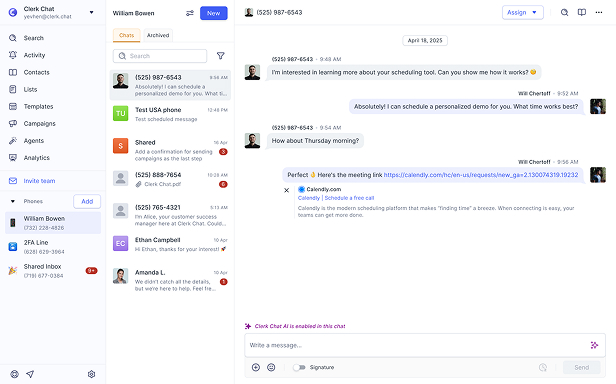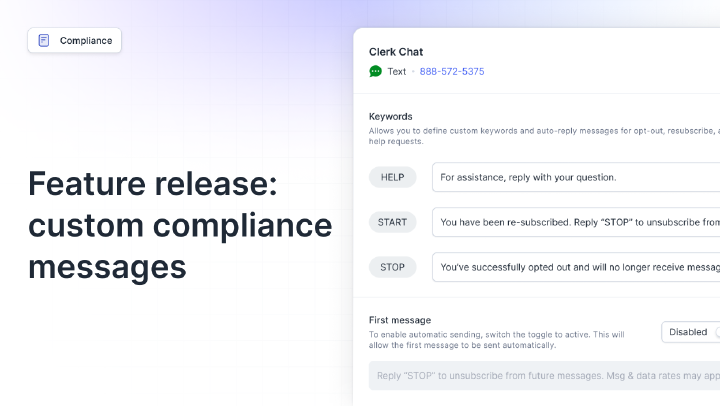P2P Messaging
[piː tuː piː ˈmɛsɪdʒɪŋ]P2P messaging enables direct, person-to-person communication between businesses and customers using standard phone numbers. This two-way texting approach creates authentic conversations that build relationships and drive results.
Why P2P Messaging Matters
P2P messaging transforms how businesses connect with customers by bringing the immediacy and convenience of personal texting into professional communications. With 98% of text messages read within minutes, P2P messaging captures attention far more effectively than email or phone calls. This direct communication channel reduces friction in customer interactions, leading to faster problem resolution and increased satisfaction.
The impact on business metrics is substantial. Companies implementing P2P messaging report 3x higher engagement rates compared to traditional channels. Customer service teams resolve issues 40% faster through text conversations, while sales teams see conversion rates increase by up to 25%. The asynchronous nature of P2P messaging allows both parties to respond at their convenience, reducing phone tag and improving productivity.
For modern consumers who prefer texting over calling, P2P messaging meets them where they’re comfortable. This preference spans all age groups, with 75% of millennials and 65% of baby boomers choosing text communication for business interactions. By offering P2P messaging, businesses demonstrate respect for customer preferences while streamlining their own operations.
How P2P Messaging Works
P2P messaging operates through business messaging platforms that connect existing phone numbers to text-enabled systems. Here’s the technical flow:
Number Configuration: Businesses enable texting on their existing landline or VoIP numbers through a messaging platform. This process, called text-enabling, maintains voice capabilities while adding SMS/MMS functionality.
Message Routing: When customers text the business number, messages route through the platform to designated team members. Smart routing rules distribute conversations based on availability, expertise, or previous interaction history.
Two-Way Communication: Staff members respond through web dashboards, mobile apps, or integrated systems like CRM platforms. Messages appear on customers’ phones as standard texts, maintaining familiar conversation threads.
Conversation Management: The platform stores all messages, creating searchable conversation histories. Features like internal notes, conversation tagging, and team collaboration tools help manage multiple simultaneous conversations efficiently.
Integration Layer: APIs connect P2P messaging with existing business systems. Customer data, purchase history, and support tickets sync automatically, providing context for personalized interactions without switching between applications.
The technical infrastructure supports multimedia messaging (MMS), allowing businesses to share images, documents, and rich media within conversations. Advanced platforms incorporate AI assistance for suggested responses while maintaining human control over actual communication.
Best Practices with P2P Messaging
Response Time Standards - Establish clear response time goals, aiming for under 5 minutes during business hours. Set up automated acknowledgments for after-hours messages, letting customers know when to expect human responses. Quick responses dramatically improve customer satisfaction and conversation completion rates.
Conversation Ownership - Assign specific team members to own entire conversations from start to finish. This continuity prevents customers from repeating information and builds rapport. Use internal handoff protocols when expertise changes are necessary, including context summaries for smooth transitions.
Message Formatting - Keep individual messages under 160 characters when possible to prevent splitting. Break complex information into digestible chunks sent sequentially. Use proper grammar and punctuation while maintaining a conversational tone that matches your brand voice.
Personalization Strategies - Reference previous interactions and customer history naturally within conversations. Use customer names appropriately and remember preferences noted in past exchanges. Avoid over-automation that makes messages feel robotic or impersonal.
Compliance Documentation - Maintain detailed records of opt-in consent, including timestamp, method, and specific language used. Regular audit conversation logs for compliance with industry regulations. Train team members on proper consent verification before initiating new conversations.
Performance Monitoring - Track key metrics including response time, conversation resolution rate, and customer satisfaction scores. Monitor message deliverability rates to identify potential carrier filtering issues. Use conversation analytics to identify training opportunities and process improvements.
Escalation Protocols - Define clear triggers for escalating text conversations to phone calls or in-person meetings. Train team members to recognize emotional cues requiring enhanced support. Maintain seamless context transfer between communication channels to preserve customer experience.
Real world examples
- Customer Service
Reduced response times by 78% through instant P2P support
Read more - Healthcare
Improved appointment confirmations by 92% with P2P reminders
Read more
Common misconceptions
Businesses widely use P2P messaging for customer service, sales, and support interactions
Modern P2P messaging works with existing phone numbers and standard mobile devices
Business P2P platforms offer encryption, compliance tools, and audit trails for security
Enterprise P2P solutions handle millions of messages with automation and team features
Related terms
In this article:
Ready to use your business number for text messaging?
Thousands of businesses are already experiencing the power of conversational messaging through SMS. Join us. Free trial and paid tiers available.
Get StartedFAQ
Have questions? We've got answers.
Find what you need quickly and clearly with our most frequently asked questions.
P2P messaging stands for person-to-person messaging, enabling direct communication between individuals using phone numbers. Unlike broadcast messaging or email campaigns, P2P creates genuine two-way conversations. It differs from application-to-person (A2P) messaging by focusing on interactive dialogue rather than one-way notifications, making it ideal for customer service, sales conversations, and personalized support.
Start by choosing a business messaging platform that supports P2P functionality with your existing phone numbers. Register for 10DLC compliance if using long codes, set up message templates for common scenarios, and train your team on response protocols. Most platforms offer APIs for integration with CRM systems, allowing you to maintain conversation history and automate initial responses while keeping the personal touch.
P2P messaging costs typically include platform subscription fees ($50-500/month based on features), per-message charges ($0.01-0.03 per SMS), and carrier fees for 10DLC registration ($125-500 one-time). Volume discounts often apply for businesses sending over 10,000 messages monthly. ROI usually justifies costs through improved customer satisfaction, reduced call center volume, and increased conversion rates.
P2P messaging provides authentic human interaction, building stronger customer relationships than pure automation. While chatbots handle simple queries efficiently, P2P excels at complex problem-solving, emotional support, and sales conversations requiring empathy. Many businesses combine both approaches, using automation for initial responses and FAQ handling, then seamlessly transitioning to human agents for nuanced interactions.
P2P messaging must comply with TCPA regulations, requiring explicit opt-in consent before initiating conversations. Businesses need 10DLC registration for improved deliverability and trust scores. GDPR applies for European customers, mandating data protection measures. Healthcare organizations must ensure HIPAA compliance for patient communications. Always include opt-out mechanisms and maintain detailed consent records for audit purposes.
Personalize messages using customer data and conversation history, respond within 5 minutes during business hours for optimal engagement. Keep messages concise (160 characters when possible), use customer names, and match their communication style. Track metrics like response rates, conversation completion, and customer satisfaction scores. A/B test message templates, timing, and call-to-action phrases to continuously improve performance.




